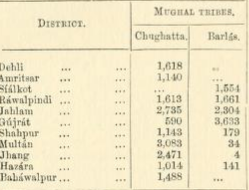The Mughal caste in Punjab
This article is an extract from PANJAB CASTES SIR DENZIL CHARLES JELF IBBETSON, K.C. S.I. Being a reprint of the chapter on Lahore : Printed by the Superintendent, Government Printing, Punjab, 1916. |
The Mughal
Caste No 37
The Mughals proper or Mongols, for the two words are only different forms of the same name, probably either entered the Panjab with Babar, or were attracted thither under the dynasty of his descendants. They are probably to be found in greatest number in the neighbourhood of Dehli, the capital of that dynasty ; and I believe that the great majority of those who have returned themselves as Mughals in the Eastern Panjab really belong to that race. They are also numerous in the Rawalpindi division and on the upper frontier, along the route of the Mughal armies, and where they find a more kindred people than in the great Panjab plains. But as will be presently explained, the number of true Mughals in these parts is certainly much smaller than would appear from our figures. The Mughals of Gujrat are described by Mr. Monckton as an unhappy race. Puffed up with pride of birth, they account themselves above all other classes except Saiyads, and even among themselves each house reckons itself higher than its neighbour. Among the clans, though of high descent, they are now at a discount. Those that might be admitted their equals, '^ such as Chibs or Gakkhars, despise them ; while to lower classes they themselves will not stoop ; and the consequence is that social relations are sometimes at a dead-lock.^^ The description applies with equal tnith to the Mughals of the Dehli territory. Even on the frontier the Mughals do not bear a good name. The Mughals tyrannize over the cultivator, and the cultivator over the earth ; and again : Trust not the MughaPs letters. Of the Mughals, first letters, then armies.
The Mughals are distributed very widely over the Province ; but are, excepting Dehli, most numerous in the western districts, and more especially in Rawalpindi, Jahlam, and Hazara. It is certain that a very large number of these men are not Mughals at all. Some, probably a considerable number of them, belong to agricultural tribes locally known by tribal names, such as Gakkhars, Sattis, Ghebas, and the like, who have set up an almost certain ly groundless claim to Mughal origin. Many of these have already been noticed. But more than this, there is a tendency, apparently confined to Dehli and the Rawalpindi and Peshawar divisions, for men of low caste to call themselves Mughals just as throughout the Province they call themselves Shekhs. Thus we find among the sub-divisions of those returned as Mughals 1512 Kahdrs in Hazara, and in Rawalpindi 3,655 Saiuis and 1,263 Rawdls ;
while in the eiglit districts just specified no fewer than 2,724 other members of 41 separate castes, for the most part of low standing, have been detected among the Mughals by a rough examination of the detailed clan tables, and this is doubtless only a specimen of what has taken place on a very ex tensive scale. Major Wace is of opinion that recent Jat converts to Mahomed often take the title of IMuo^hal. On the other hand no fewer than
2,510 persons have returned them selves as Pathan by caste and Mughal by tribe, of whom ],169 arein the Peshawar district, 746 in the Derajat, and 401 in Ra walpindi and Jalilam. Further light will doubtless be thrown upon the composition of the so-called Mughals when the de tailed tables are jjublished. Of the trae Mughal tribes, only the Chughatta and the Barlas seem to be numerously represented in the Pan jab, the former number ing 23,593 and the latter 12,137. Men so returned are probably true Mughals. Their numbers for the districts in which they are shown as numerous are given in the margin. Besides these 1,543 of the Rawalpindi Mughals return themselves as Gakkhar and 3,861 as Kayaui, the latter also of which names perhaps refer to the Gakkhars, who sometimes claim to be Kayani. ^ In 1864, Colonel Cracroft gave the number of trae Mughals in the Rawalpindi district at 2,767 souls. At last Census there were 8,205.
